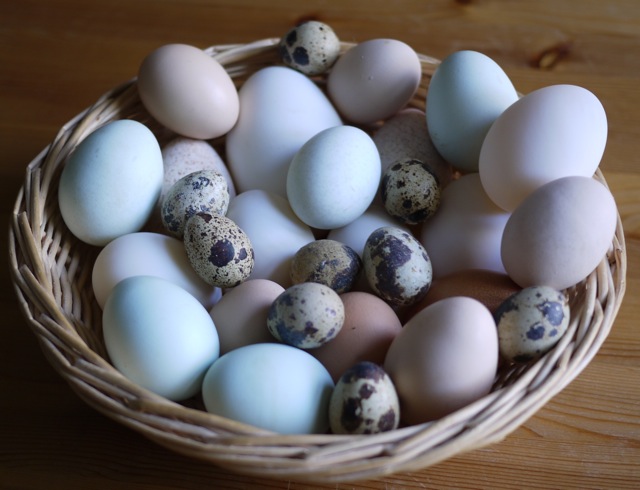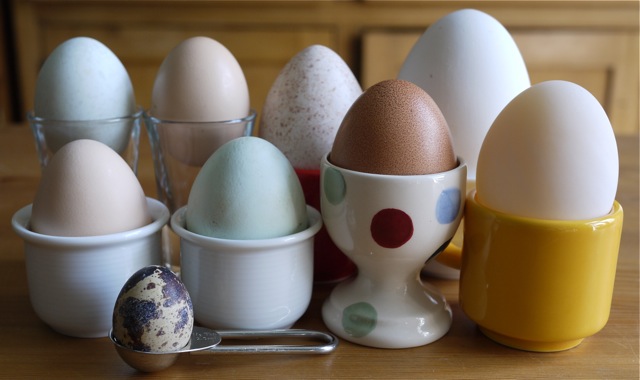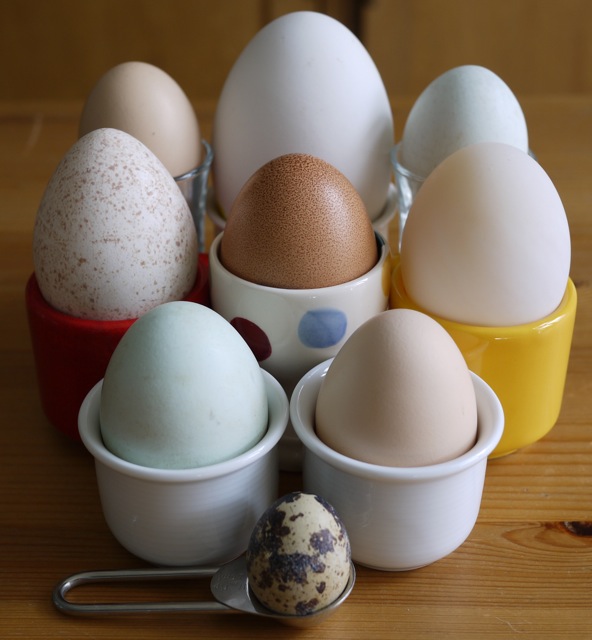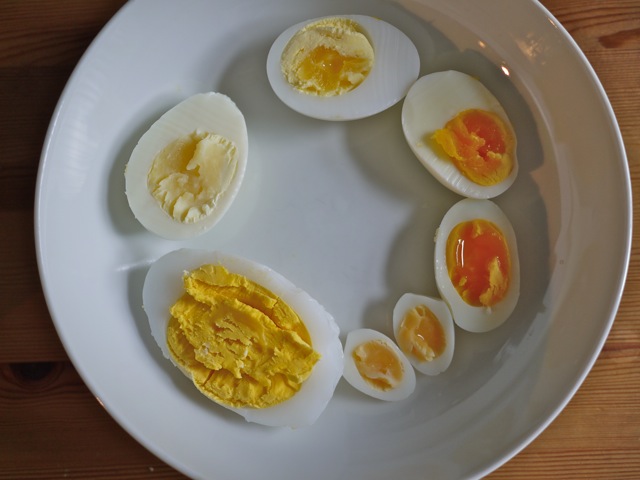This article was first published in Francoise Murat & Associates newsletter in April 2010.
We’ve just had Easter eggs, egg-decorating competitions at school and the hens are laying well again. With year round supplies of eggs in the shops we forget they are seasonal. We forget that when we talk of eggs we mean hen’s eggs. Anyone who keeps a few hens knows that during the winter they hardly lay at all and it takes until spring for them to get back to producing an egg a day. Jane Grigson talks of eggs as a rarity in the winter months and preserving them in late summer in isinglass to last through the autumn. Others cite coating eggs in wax to preserve them. Modern hen breeds produce up to 250 eggs per year but that’s still 165 days when they don’t lay, earlier breeds produced as few as 50 eggs.
Its not just hens eggs that are seasonal, now is the time to track down something different. It’s relatively easy to find duck and quails eggs in farm shops and markets, goose eggs are a bit more difficult to come by. Other eggs are harder to find. You need a good local source and then you might be able to try bantam, guinea fowl (not until June), gulls or pheasant and even turkey eggs. Friends and neighbours with a surfeit of eggs from now through until summer will be happy to share. Be sure to offer something in return, bird feed isn’t cheap even if the grass they have foraged on is free.
With this in mind I decided to collect a selection of eggs and do a little comparative taste test. I was able to get bantam and different hens’ eggs from friends. Duck, goose and quail I spotted at the farm shop but when I went back to get them someone had come in and snapped up 6 lots of 24 quail eggs, and all the duck eggs, that’s a lot of eggs. I bought a goose egg and then found Clarence Court sell duck and quail eggs via Ocado so I bagged some from there. On the ever-fascinating Twitter, I saw Sarah of Brays Cottage having scrambled turkey eggs for breakfast (as part of her Norfolk Diet) and she kindly got some more from her neighbour and sent them by post.
With my collection of eggs ready I pondered how to cook them for the taste test. Both old and new books listed a huge number of recipes and ways of cooking eggs. Treatises on egg farming, the science of cooking eggs, and eggs in different cuisines diverted me. I was reminded that Grimod de la Reynière says ‘The egg is …such an indispensable necessity that the most skilful cook will renounce his art if he is forbidden to use them’. After all the searching I decided simple was best. I planned a grand breakfast of soft-boiled eggs, then recalling how full I was last time I had goose egg for breakfast I decided hard-boiled was better as I could sample a slice of each and then save the rest for later.
But how best to boil an egg? Something so simple the British public was offended when Delia Smith promised to teach us. A little background reading of Harold McGee and Hervé This on the science of cooking eggs made me realise that it wasn’t quite as simple as it seemed. Hervé This investigates how to cook the perfect hard-boiled egg to ensure that: the shell doesn’t crack, the shell peels easily, the white isn’t rubbery, the yolk isn’t sandy, the egg isn’t sulphury and the yolk is centred!
Hervé This’ Perfect Hard-Boiled Eggs – as interpreted by me:
- Take one or more egg
- Prick egg on the wide end with a pin to make a small hole, this prevents cracking.
- Place egg in water that’s is between 70-90C i.e. not boiling.
- Cook at below 90C for the usual time for the type of egg; this cooks with no rubberyness, no sandyness or sulphur smells.
- During the cooking keep rolling egg over in the water, this keeps the yolk centred.
- Lift egg from the water and place in cold water, this stops the cooking.
- Place egg in vinegar for several hours, the shell will dissolve. I find that eggs that are slightly older peel more easily.
And the taste test. The main differences are in yolk and white colour and ratio. The tastes were almost indistinguishable. Good fun to try the different eggs though.






 Back in the kitchen it was time for breakfast. Into a pan of luke warm water went my goose egg, brought it up to a simmer and then cooked at that pace for 10 minutes (next time I’d do it for a little less to get a more runny yolk), hubby fried his egg for around 4 minutes or so and we dashed off some toast for each of us. Then to eating.
Back in the kitchen it was time for breakfast. Into a pan of luke warm water went my goose egg, brought it up to a simmer and then cooked at that pace for 10 minutes (next time I’d do it for a little less to get a more runny yolk), hubby fried his egg for around 4 minutes or so and we dashed off some toast for each of us. Then to eating. The white is a more boingy texture than a hen’s egg and a different shade of white (kind of translucent even when cooked) but similar in taste. The yolk is huge, a lovely yellow and to start with you think its not that much richer than hen’s eggs but at you munch your way through you realise its kind of cumulative and by the end I was hard pushed to think I’d want another bite. It was truly delicious, a great treat for a Sunday breakfast and next time I see any I’ll be getting another couple.
The white is a more boingy texture than a hen’s egg and a different shade of white (kind of translucent even when cooked) but similar in taste. The yolk is huge, a lovely yellow and to start with you think its not that much richer than hen’s eggs but at you munch your way through you realise its kind of cumulative and by the end I was hard pushed to think I’d want another bite. It was truly delicious, a great treat for a Sunday breakfast and next time I see any I’ll be getting another couple.